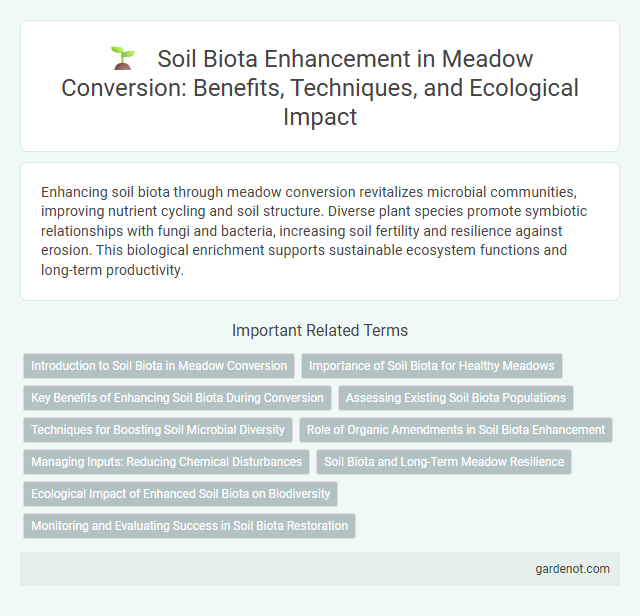Enhancing soil biota through meadow conversion revitalizes microbial communities, improving nutrient cycling and soil structure. Diverse plant species promote symbiotic relationships with fungi and bacteria, increasing soil fertility and resilience against erosion. This biological enrichment supports sustainable ecosystem functions and long-term productivity.
Introduction to Soil Biota in Meadow Conversion
Soil biota plays a crucial role in meadow conversion by improving soil structure, nutrient cycling, and organic matter decomposition. Diverse communities of bacteria, fungi, earthworms, and arthropods promote plant health and resilience by enhancing nutrient availability and soil aeration. Optimizing soil biota supports sustainable meadow ecosystems and increases productivity through natural biological processes.
Importance of Soil Biota for Healthy Meadows
Soil biota, including bacteria, fungi, earthworms, and insects, play a critical role in maintaining the health and productivity of meadows by enhancing nutrient cycling and soil structure. Their activity promotes organic matter decomposition, improving soil fertility and water retention essential for diverse plant growth. Healthy soil biota populations increase resilience to pests and diseases while supporting carbon sequestration in meadow ecosystems.
Key Benefits of Enhancing Soil Biota During Conversion
Enhancing soil biota during meadow conversion significantly improves nutrient cycling, leading to healthier plant growth and increased biodiversity. A robust soil microbial community enhances soil structure, water retention, and resilience against erosion and drought. These benefits collectively promote sustainable ecosystem restoration and long-term soil fertility.
Assessing Existing Soil Biota Populations
Assessing existing soil biota populations is crucial for effective meadow conversion, involving detailed analysis of microbial diversity, earthworm density, and fungal networks. Soil samples are collected and analyzed using DNA sequencing and microscopy to identify key organisms responsible for nutrient cycling and soil structure maintenance. Understanding baseline biota health informs targeted interventions to enhance soil fertility and ecosystem resilience during meadow restoration.
Techniques for Boosting Soil Microbial Diversity
Techniques for boosting soil microbial diversity in meadow conversion include organic matter amendments, such as compost and biochar, which provide essential nutrients and improve soil structure. Incorporating diverse plant species with varying root exudates supports a wide range of microbial communities, enhancing soil health and nutrient cycling. Applying microbial inoculants and minimizing soil disturbance further promote a resilient and diverse soil biota essential for sustainable meadow ecosystems.
Role of Organic Amendments in Soil Biota Enhancement
Organic amendments such as compost, manure, and biochar play a crucial role in enhancing soil biota by providing essential nutrients and improving soil structure, which supports microbial diversity and activity. These amendments increase soil organic matter, fostering a thriving community of bacteria, fungi, and earthworms that drive nutrient cycling and promote plant growth in meadow conversion projects. Enhanced soil biota resulting from organic amendments leads to greater soil fertility, improved water retention, and resilience against pests and diseases.
Managing Inputs: Reducing Chemical Disturbances
Managing inputs in meadow conversion by reducing chemical disturbances significantly enhances soil biota diversity and activity. Limiting or eliminating synthetic fertilizers, pesticides, and herbicides preserves beneficial microbial communities essential for nutrient cycling and soil structure. This sustainable practice promotes long-term soil health, supporting robust plant growth and ecosystem resilience.
Soil Biota and Long-Term Meadow Resilience
Enhancing soil biota through meadow conversion increases microbial diversity, which improves nutrient cycling and soil structure, fostering long-term meadow resilience. Rich soil biota supports plant root systems by enhancing water retention and disease resistance, crucial for sustainable meadow ecosystems. Sustained soil biological activity underpins ecosystem stability, promoting recovery from environmental stresses and maintaining biodiversity.
Ecological Impact of Enhanced Soil Biota on Biodiversity
Enhanced soil biota in meadow conversions significantly improves soil health by increasing microbial diversity and activity, which promotes nutrient cycling and organic matter decomposition. This boost in soil organisms supports a wider range of plant species, fostering aboveground biodiversity and habitat complexity. The resulting ecological balance enhances ecosystem resilience and stability, contributing to long-term conservation goals.
Monitoring and Evaluating Success in Soil Biota Restoration
Monitoring soil biota restoration in meadow conversion involves assessing microbial diversity, earthworm populations, and fungal networks using DNA sequencing and soil respiration rates to gauge ecosystem health. Regular evaluation of soil nutrient cycling and organic matter decomposition rates provides insight into soil functionality improvements and biotic activity levels. Success criteria include increased soil biodiversity indices, enhanced nutrient availability, and restoration of natural soil food webs indicative of a resilient and productive meadow ecosystem.
Soil biota enhancement Infographic

 gardenot.com
gardenot.com